|
 |
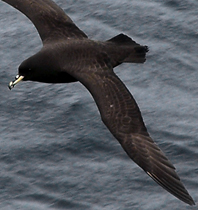 | White-chinned Petrel (Procellaria aequinoctialis).  |
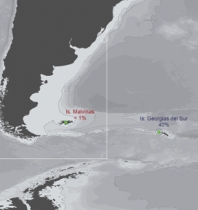 |
Regional Nesting Sites of the White-chinned Petrel (Procellaria aequinoctialis).
References. Green dots: colonies and the percentage of the world population that each area represents. Blue text: populations for which the Atlas provides distribution data. Red text: populations for which there are no data. Blue circle: colonies of origin of individuals studied.
| © Mark Royo Celano |
 |
Nesting sites |
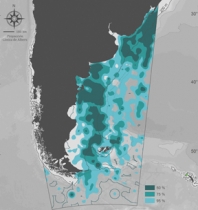 Principal feeding areas Principal feeding areas |
The White-chinned Petrel is the species that makes widest use of the Patagonian Sea, with areas of high intensity of continuous use from north to south and east to west throughout the target area.
Data from 15 adults from South Georgia (information obtained by satellite-transmitters on 5 individuals and geolocators on 10 individuals). All available data between January and December are included, without distinguishing between the seasons.
Dataholders: J. Croxall, P. Trathan and R. Phillips.
 |  Spring-Summer (S. Georgia) Spring-Summer (S. Georgia) |
During the breeding season White-chinned Petrel adults use areas of the continental shelf and the slope of the Patagonian Sea, principally the area surrounding the Malvinas Islands and some shelf zones opposite the province of Chubut. During incubation (spring) they make very long foraging trips. While rearing their young (summer), they feed primarily in sub-Antarctic waters outside the target area.
Data (collected by satellite instruments) on adults, 2 in spring and 3 in summer, from South Georgia. Period: November-February.
Dataholders: J. Croxall, P. Trathan and R. Phillips.
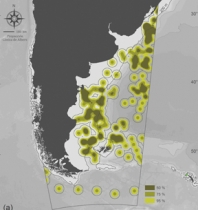 Spring (S. Georgia) Spring (S. Georgia) |
In the southern spring, White-chinned Petrel adults use areas of the shelf and slope opposite the San Jorge Gulf and Valdes Peninsula, around the Malvinas Islands and areas of the Argentine Basin.
Data (collected by geolocators) are on 9 adults, males and females, from South Georgia. Period: Spring.
Dataholders: J. Croxall, P. Trathan and R. Phillips.
 | 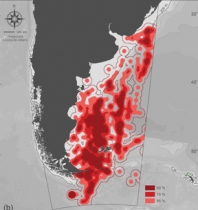 Summer (S. Georgia) Summer (S. Georgia) |
During the summer, the slope and the shelf to the south of the Patagonian Sea are more important feeding areas for the White-chinned Petrel adults.
Data (collected by geolocators) are on 9 adults, males and females, from South Georgia. Period: Summer.
Dataholders: J. Croxall, P. Trathan and R. Phillips.
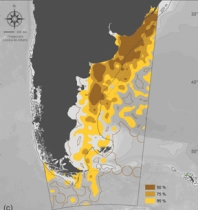 Autumn (S. Georgia) Autumn (S. Georgia) |
In autumn, White-chinned Petrel adults make intensive use of the northern shelf and slope, especially off Río de la Plata, Uruguay and south of Brazil.
Data (collected by geolocators) are on 10 adults, males and females, from South Georgia. Period: Autumn.
Dataholders: J. Croxall, P. Trathan and R. Phillips.
 | 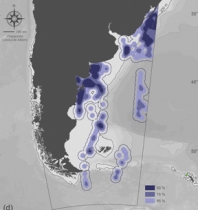 Winter (S. Georgia) Winter (S. Georgia) |
In winter, White-chinned Petrel adults feed in coastal waters, on the shelf at El Rincon, San Matias Gulf and Valdes Peninsula, as well as the south of Brazil.
Data (collected by geolocators) are on 8 adults, males and females, from South Georgia. Period: Winter.
Dataholders: J. Croxall, P. Trathan and R. Phillips.
|
 |
White-chinned Petrel
Procellaria aequinoctialis
Regional Nesting Sites: It breeds on the Malvinas, South Georgia (40% of the world population), Prince Edward, Crozet, Kerguelen, Auckland, Campbell and Antipodes islands. Diet: White-chinned Petrel feeds mostly on krill, squid and to a lesser extent, fish. It can dive up to 13 m in depth in search of prey or to feed on bait attached to hooks being fished by longliners. World breeding population: Although the global population of this species is not known, rough estimates suggest a total of 7,000,000 adults. Conservation Status: Vulnerable (IUCN, 2008). Main threats: Incidental mortality in longline fisheries is the principal threats, but it also suffers from predation (by introduced rats at breeding islands) and the loss of breeding habitat.

|

